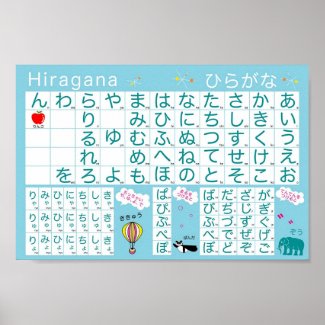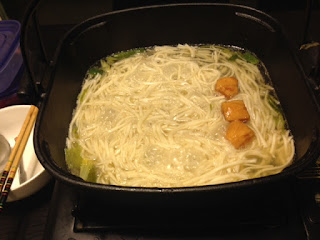Greetings in Japanese、Aisatsu, in Japanese.
おはよう こんにちは こんばんは ありがとう さようなら すみません
ohayou おはよう is "good morning". we usually don't use Kanji for this word but if you use it, it says お早う the Kanji in the middle means "early" or "fast" It makes sense since it's early in the morning.
Ko n ni chi ha こんにちは is "hello" but we say this for the afternoon. 今日は the first two Kanji characters says Today, は pronounces "wa" even though it spells "ha". In Japanese, this は pronounces "wa" works as "is" or "are" in English. postpositional particle I looked upon a dictionary..
so, "Konnichiwa" really means "today is"
Same as "Konbanwa" night greetingsこんばんは 今晩は means "tonight is"
Arigatou ありがとう is Thank you, in Kanji, it 有難う the first kanji means "there" second one is "difficult" so Arigatou means "difficult to be there" so this expresses appreciations for things are there.
My yoga teacher says the opposite of Arigatou is taking it for granted "Atarimae" あたりまえ
it's deep, isn't it?
Next one is, Sayounara (when you spell in English there's no "u" in the middle, but there are "u" to spell in Japanese) さようなら if you write in Kanji, "左様なら" it may be translated to "Ok then,"
Sumimasen, すみません 済みません means excuse me but,
This world comes from "I'm not done" or "I'm not satisfied with myself for what I have done." wow, heavy! nobody put that feeling to this word anymore but originally, it means like that.
I hope you memorized these words today.
Please subscribe and check out other videos too!
Showing posts with label Japanese. Show all posts
Showing posts with label Japanese. Show all posts
Sunday, July 7, 2019
Sunday, June 23, 2019
Writing / Typing Japanese: Dotted letters and so on
I'll tell you how to type beyond usual Hiragana chart.
Japanese Hiragana and Katakana, if you add two dots after those letters for example
かきくけこ
Ka Ki Ku Ke Ko
add " at the right above those letters, they becomes
がぎぐげご
it pronounces
Ga Gi Gu Ge Go
Same for さしすせそ becomes
ざじずぜぞ
Za Zi Zu Ze Zo
だぢづでど
Da Di Du De Do
ばびぶべぼ
Ba Bi Bu Be Bo
Then, if you put small circle at the right side above, they becomes
ぱぴぷぺぽ
Pa Pi Pu Pe Po
Next, if you put little や、ゆ、よ after certain letters, you will pronounce for example,
きゃ = kya
きゅ = kyu
きょ = kyo
Like when you type kyouto (Kyoto) きょうと =京都 in Kanji
you will see よ is little smaller.
Sha Shu Sho
しゃしゅしょ
Tya Tyu Tyo
ちゃちゅちょ
Nya Nyu Nyo
にゃにゅにょ
Hya Hyu Hyo
ひゃひゅひょ
Mya Myu Myo
みゃみゅみょ
Rya Ryu Ryo
りゃりゅりょ
Gya Gyu Gyo
ぎゃきゅぎょ
Ja Ju Jo
じゃじゅじょ
Bya Byu Byo
びゃびゅびょ
Pya Pyu Pyo
ぴゃぴゅぴょ
Japanese Hiragana and Katakana, if you add two dots after those letters for example
かきくけこ
Ka Ki Ku Ke Ko
add " at the right above those letters, they becomes
がぎぐげご
it pronounces
Ga Gi Gu Ge Go
Same for さしすせそ becomes
ざじずぜぞ
Za Zi Zu Ze Zo
だぢづでど
Da Di Du De Do
ばびぶべぼ
Ba Bi Bu Be Bo
Then, if you put small circle at the right side above, they becomes
ぱぴぷぺぽ
Pa Pi Pu Pe Po
Next, if you put little や、ゆ、よ after certain letters, you will pronounce for example,
きゃ = kya
きゅ = kyu
きょ = kyo
Like when you type kyouto (Kyoto) きょうと =京都 in Kanji
you will see よ is little smaller.
Sha Shu Sho
しゃしゅしょ
Tya Tyu Tyo
ちゃちゅちょ
Nya Nyu Nyo
にゃにゅにょ
Hya Hyu Hyo
ひゃひゅひょ
Mya Myu Myo
みゃみゅみょ
Rya Ryu Ryo
りゃりゅりょ
Gya Gyu Gyo
ぎゃきゅぎょ
Ja Ju Jo
じゃじゅじょ
Bya Byu Byo
びゃびゅびょ
Pya Pyu Pyo
ぴゃぴゅぴょ
Friday, August 4, 2017
My gut is boiling with anger.
Harawata ga niekurikaeru. means My gut is boiling.
This is a Japanese expression.
Harawata is intestine. There are so many expression to connect intestine and emotion. I read some articles about intestine health and mental health is closely connected.
My son's scooter (not a razor, pro scooter, its expensive) was stolen by the same elementary school boy. My son and his friend were inside a seven eleven and they noticed my son's scooter was taken by a boy and his older brother. They rushed outside and chased them but they lost them after the first left at the end of the block. My son cried so much and came home. I went with them to search for the boy and tried to find where they were, but no luck.
We came back home and called police. They'll look into the camera.
I hope my son's scooter is coming back soon.
This is a Japanese expression.
Harawata is intestine. There are so many expression to connect intestine and emotion. I read some articles about intestine health and mental health is closely connected.
My son's scooter (not a razor, pro scooter, its expensive) was stolen by the same elementary school boy. My son and his friend were inside a seven eleven and they noticed my son's scooter was taken by a boy and his older brother. They rushed outside and chased them but they lost them after the first left at the end of the block. My son cried so much and came home. I went with them to search for the boy and tried to find where they were, but no luck.
We came back home and called police. They'll look into the camera.
I hope my son's scooter is coming back soon.
Wednesday, November 25, 2015
Asian Party Dish, Nabe
Are you ready for the holiday? It's getting chilly out, For a lot of us, Japanese, (or Asian), it's time to enjoy Nabe. We cook vegetable and meat, fish on a table and dip on a favorite sauce.
Once you prepare ingredients, you can cook as you eat, sitting around the table, we would take turn to cook, serve, and eat with favorite drink such as sake. I recently enjoyed Thai style nabe. The recipe is for about 4 people.
Ingredients are simple. You'll need half of a whole Chinese cabbage, green onion, next to Chinese cabbage is called "Shungiku" (garland chrysanthemum) You can find those vegetable at Asian market, but you can skip some ingredients if you can't find them.
On this Thai Nabe, I used Cilantro, if you have Asian market near you, you can buy Shirataki (konnyaku noodles), Enoki mushroom, and Tofu (may be you can get all over nowadays).
Chop all vegetables/tofu into bitable size, boil over konnyaku noodles and chop.
For meat and fishes, thin sliced meet (beef in pic and shrimp devined and peeled or any kind of fish or meat as you like. I added fish ball, and made some shrimp wan ton.
Make dipping sauce. For Thai dip sauce, you'll need
6 table spoon lemon juice
6 table spoon fish sauce
2 tea spoon sugar
1 or 2 clove of garlic, chopped
5 stems of cilantro, chopped
Just mix them.
For Japanese nabe, you can use ponzu (soy sauce plus some lemon juice) for the dipping sauce.
You can add chopped cilantro, garlic, and Chinese chili sauce on your dipping sauce as you like.
On a portable stove on the table you are gathering at, put a pot, you can use usual pot.
The soup is one litter of chicken broth, chopped lemon grass stem, and cilantro stems.
For usual Japanese nabe, we would use kelp broth (a 1 inch square dry kelp with about an litter of water) with a few table spoon of soy sauce, sake, and so on.
You don't need to make it salty since you'll dip the food to your dipping sauce later.
Put a lid and wait for boiling soup..
Once the broth is boiled, put tofu, shirataki, Chinese cabbage, green onions, fish ball, but not the meat or fish.You don't have to put all the meat, or vegetable at once. cook as you eat.
Add some meat and fish to the boiling pot. put lid and wait for a while.
It's cooked! Add soup on nabe when it seems little low later on before you add more vegetable or meat. you can add some water since it's already flavorful.
Serve on individual bowl and eat with dipping sauce and topping.
After you scoop up all the meat and vegetable, add some cooked Udon noodle or cooked rice and boil and serve. This is called Shime in Japanese. (means finishing up)
This burner is handy for camping too!
This is similar to what I have.
More recipes!
On this Thai Nabe, I used Cilantro, if you have Asian market near you, you can buy Shirataki (konnyaku noodles), Enoki mushroom, and Tofu (may be you can get all over nowadays).
Chop all vegetables/tofu into bitable size, boil over konnyaku noodles and chop.
6 table spoon lemon juice
6 table spoon fish sauce
2 tea spoon sugar
1 or 2 clove of garlic, chopped
5 stems of cilantro, chopped
Just mix them.
For Japanese nabe, you can use ponzu (soy sauce plus some lemon juice) for the dipping sauce.
You can add chopped cilantro, garlic, and Chinese chili sauce on your dipping sauce as you like.
The soup is one litter of chicken broth, chopped lemon grass stem, and cilantro stems.
For usual Japanese nabe, we would use kelp broth (a 1 inch square dry kelp with about an litter of water) with a few table spoon of soy sauce, sake, and so on.
You don't need to make it salty since you'll dip the food to your dipping sauce later.
Serve on individual bowl and eat with dipping sauce and topping.
After you scoop up all the meat and vegetable, add some cooked Udon noodle or cooked rice and boil and serve. This is called Shime in Japanese. (means finishing up)
This burner is handy for camping too!
This is similar to what I have.
More recipes!
Labels:
Asian,
Black Friday,
Easy,
gathering,
Holiday meals,
Japanese,
Nabe,
Party,
recipe,
Thai
Sunday, October 26, 2014
Gyoza : Dumplings Recipe
Ground pork : 150 gram
Cabbage : 200 gram
Green onion : 2 or 3 strings
grated ginger : about 1 tea spoon
Chinese chive (if available) : 50 gram
Soy Sauce 1/2 tea spoon
Salt 1/2 tea spoon
Sake (Japanese rice wine) 1 table spoon
Sesame Oil 1 tea spoon
Gyoza Skin : 1 pack
1) Boil cabbage for a few minute, drain and squeeze off the liquid and chop into mince. chop all other vegetables. throw in meat and all the seasonings in a bowl and mix well with your hands (yack!)
2) Put spoonful of the mixture above on the gyoza skin.
Wet the half end and fold in to make a gyoza.
You can make about 30 gyoza with ingredients above.
Flip the gyoza and add 1/4 cup of the water and put a lid on a pan. simmer for 3 to 4 minute. let the water evaporate and make gyoza crunchy with a golden mark. Serve and enjoy with a soy sauce!
Some people make gyoza skin but I've never made them.
Get a PFOA free pan!!
Get a PFOA free pan!!
I make peace t-shirts. Check out at Peace Wings Apparel
Subscribe to:
Comments (Atom)




















